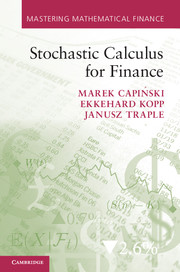2 - Wiener process
Published online by Cambridge University Press: 05 November 2012
Summary
Scaled random walk
As is the case throughout this series, the motivation for the mathematical results and techniques we discuss comes from their application to financial markets. It may seem reasonable to argue that discrete-time market models suffice for such applications, since every transaction takes a finite length of time, and this is what we did in [DMFM]. In practice, however, the problems with this approach multiply rapidly once one recognises the computational hazards involved in seeking to model a stock whose price may be adjusted every few minutes over a period of (say) three months. Keeping track of all the possible scenarios rapidly becomes infeasible and we seek recourse to approximating such large-scale finite discrete models by continuous-time idealisations which may provide qualitative and quantitative insights into the stochastic behaviour being observed.
We therefore turn to a study of continuous-time stochastic processes. Thus we shall allow an interval of the form [0, T] as our time set and study the evolution of random variables X(t), where t ∈ [0, T]. A family of random variables (X(t))t∈[0,T] is called a (continuous-time) stochastic process. The study of such processes has many applications beyond finance, of course, and it is customary to use the unbounded interval [0,∞) as the time set. For finance applications, it usually suffices to restrict attention to a finite time interval, because, as John Maynard Keynes famously observed: ‘In the long run we are all dead.’
- Type
- Chapter
- Information
- Stochastic Calculus for Finance , pp. 36 - 77Publisher: Cambridge University PressPrint publication year: 2012

